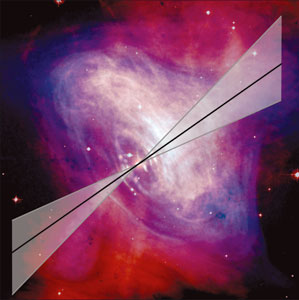Several sources of very high-energy gamma-rays are associated with pulsars, revealing that these spinning neutron stars are extremely powerful particle accelerators. The discovery with ESA’s International Gamma-ray Astronomical Laboratory (INTEGRAL) satellite that the gamma-ray emission of the Crab Nebula is strongly polarized along the direction of its spin axis locates the acceleration site in the close vicinity of the pulsar.

Image credit: NASA/CXC/ASU/J Hester et al. (for the Chandra image); NASA/HST/ASU/J Hester et al. (for the Hubble image)
The Crab Nebula is the aftermath of a supernova explosion witnessed by Chinese and Arab astronomers in the year 1054. The core of the dying star collapsed to form a neutron star while the outer layers were expelled; their on-going interaction with the interstellar medium produces the beautiful remnant seen nowadays. A neutron star can be thought of as a giant atomic nucleus about 20–30 km across, in which each cubic millimetre weighs about 100,000 tonnes. The neutron star at the centre of the Crab Nebula is actually a pulsar sending radiation pulses 30 times per second, each time the magnetic pole of the spinning neutron star points towards the Earth.
The high-resolution X-ray image of the Crab Nebula obtained by NASA’s Chandra satellite revealed a complex geometry with a collimated jet, thought to be aligned with the spin axis of the neutron star surrounded by a toroidal, doughnut-shaped structure. However, the much lower resolution of current hard X-ray and gamma-ray instruments cannot locate precisely the site of high-energy emission within the Crab Nebula.
A possible clue comes from the study of the polarization properties of the high-energy radiation, a difficult task that has now been achieved for the first time by European astronomers analysing data from the INTEGRAL’s spectrometer. The study, led by Anthony Dean of the University of Southampton, is based on more than 600 individual observations of the Crab taken between February 2003 and April 2006.
The polarization of a gamma-ray photon can be derived if it is scattered off an electron from one detector element to another. This Compton-scattering has a preferred direction related to the polarization angle of the incoming photon. About half a million such events were detected from the Crab Nebula during the quiescent phase of the pulsar cycle, with photon energies between 0.1 and 1 MeV. These data were then fitted to the results of intensive Monte Carlo simulations using GEANT4. The best fit was obtained for a polarization of 46 ± 10% and a polarization angle of 123° ± 11°, closely aligned with the direction of the pulsar spin and the X-ray jet.
This large fraction of polarized photons implies that the high-energy electrons emitting them are accelerated with a high degree of order in a structure apparently closely linked to the spin axis of the pulsar. By considering either synchrotron radiation or curvature radiation, Dean and colleagues estimate a typical electron energy of 1014 to 1015 eV. This is about 1000 times the energy reached by CERN’s LEP collider and is enough to explain the production – by interactions with visible or microwave photons within the Crab Nebula – of the very high-energy gamma-rays detected by Cherenkov telescopes.







